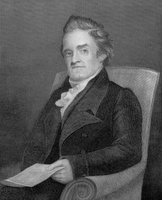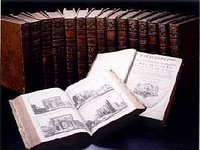December 9
 Ever since the advent of printing presses with movable type in the 15th century, newspapers have been offered to the reading public. Actually, it would be a bit more accurate to say that since the introduction of these presses in the middle of the 1400s papers featuring news have been offered to the literate members of many communities. Generally, these were broadsheets with no fixed schedule of publication and circulation was limited for the most part to bulletin boards, walls of taverns and other similar locations where a sheet of paper could be tacked up. It was inevitable that the idea of publishing a proper newspaper would eventually strike someone. I mean, they had all these words just lying around cluttering things up and somebody had to come up with a way to get rid of at least some of them. On the 9th of December in 1793, Noah Webster began publication of the American Minerva, the City of New York’s first daily newspaper. Webster would achieve lasting literary fame when on January 15, 1806 he published his book “A Compendious Dictionary of the English Language” which remains in print today as Webster’s Unabridged Dictionary.
Ever since the advent of printing presses with movable type in the 15th century, newspapers have been offered to the reading public. Actually, it would be a bit more accurate to say that since the introduction of these presses in the middle of the 1400s papers featuring news have been offered to the literate members of many communities. Generally, these were broadsheets with no fixed schedule of publication and circulation was limited for the most part to bulletin boards, walls of taverns and other similar locations where a sheet of paper could be tacked up. It was inevitable that the idea of publishing a proper newspaper would eventually strike someone. I mean, they had all these words just lying around cluttering things up and somebody had to come up with a way to get rid of at least some of them. On the 9th of December in 1793, Noah Webster began publication of the American Minerva, the City of New York’s first daily newspaper. Webster would achieve lasting literary fame when on January 15, 1806 he published his book “A Compendious Dictionary of the English Language” which remains in print today as Webster’s Unabridged Dictionary.
December 8
 It often takes a while for the effects of a spectacular invention to be felt. Movable type may have been perfected in Korea in the 13th century but movable type was not introduced to the Western world until the middle of the fifteenth century when Johannes Gutenberg perfected a printing press with movable type that sent ripples through the world. Gutenberg’s press allowed books to be produced with greater speed and at remarkably lower cost. Steadily rising literacy rates in Europe established a strong market for books of all sorts, though it would take several more centuries for scandal sheets to be perfected. The very first public library was the Bodleian Library in Oxford, England, opened in 1602 with Thomas Bodley’s collection of 2000 books as its centerpiece. A few years later, in Milan, Italy, the Biblioteca Ambrosiana, the second oldest public library, opened its reading room on the 8th in 1609.
It often takes a while for the effects of a spectacular invention to be felt. Movable type may have been perfected in Korea in the 13th century but movable type was not introduced to the Western world until the middle of the fifteenth century when Johannes Gutenberg perfected a printing press with movable type that sent ripples through the world. Gutenberg’s press allowed books to be produced with greater speed and at remarkably lower cost. Steadily rising literacy rates in Europe established a strong market for books of all sorts, though it would take several more centuries for scandal sheets to be perfected. The very first public library was the Bodleian Library in Oxford, England, opened in 1602 with Thomas Bodley’s collection of 2000 books as its centerpiece. A few years later, in Milan, Italy, the Biblioteca Ambrosiana, the second oldest public library, opened its reading room on the 8th in 1609.
December 7
 On the 7th in 1972, onboard the Apollo 17 spacecraft, the last manned mission to the moon, Jack ‘Harrison’ Schmitt, the lunar module pilot, snapped what has come to be known as ‘The Blue Marble’ photograph. Schmitt’s comment upon taking the picture was “Ah! You see one Earth, you’ve seen them all.”
On the 7th in 1972, onboard the Apollo 17 spacecraft, the last manned mission to the moon, Jack ‘Harrison’ Schmitt, the lunar module pilot, snapped what has come to be known as ‘The Blue Marble’ photograph. Schmitt’s comment upon taking the picture was “Ah! You see one Earth, you’ve seen them all.”
December 6
 On the 6th in 1768 Scotsmen Colin Macfarquhar, a printer, and Andrew Bell, an engraver, published the first section of the Encyclopædia Britannica. The editor was William Smellie (what a horrid last name). When completed in 1771 the first full edition consisted of 2,391 pages divided into three volumes. Time has been kind to the Britannica and today there are, in addition to the print edition, online and CD versions. The CD version contains over 55 million words. In spite of the dramatic digital expansion of the books, for collectors the 1911 edition is the one to have. For some reason the 1911 is the 1957 Fender Stratocaster of books.
On the 6th in 1768 Scotsmen Colin Macfarquhar, a printer, and Andrew Bell, an engraver, published the first section of the Encyclopædia Britannica. The editor was William Smellie (what a horrid last name). When completed in 1771 the first full edition consisted of 2,391 pages divided into three volumes. Time has been kind to the Britannica and today there are, in addition to the print edition, online and CD versions. The CD version contains over 55 million words. In spite of the dramatic digital expansion of the books, for collectors the 1911 edition is the one to have. For some reason the 1911 is the 1957 Fender Stratocaster of books.
December 5
 Niccolò Sfondrati, was born on February 11, 1535. Born into a rather prosperous family he early on achieved a reputation for modesty and piety. He entered the priesthood and in 1560 was made a cardinal by Pope Gregory XIII. On the 5th of December in 1590, at the conclave held upon the death of Pope Urban, Sfondrati was elevated to the papacy and assumed the name Pope Gregory XIV. When informed of his election he purportedly burst into tears and responded to the cardinals who informed him by stating “God forgive you! What have you done?” In March of 1591 he issued his first papal bull, Cogit nos, in which he forbade under pain of excommunication ‘all betting concerning the election of the Pope, the duration of a pontificate, or the creation of new cardinals.’ Gregory XIV would die on October 16, 1591 making his pontificate one of the shorter ones in church history. There are no records extant indicating the odds on his dying on that day or what the payoff was.
Niccolò Sfondrati, was born on February 11, 1535. Born into a rather prosperous family he early on achieved a reputation for modesty and piety. He entered the priesthood and in 1560 was made a cardinal by Pope Gregory XIII. On the 5th of December in 1590, at the conclave held upon the death of Pope Urban, Sfondrati was elevated to the papacy and assumed the name Pope Gregory XIV. When informed of his election he purportedly burst into tears and responded to the cardinals who informed him by stating “God forgive you! What have you done?” In March of 1591 he issued his first papal bull, Cogit nos, in which he forbade under pain of excommunication ‘all betting concerning the election of the Pope, the duration of a pontificate, or the creation of new cardinals.’ Gregory XIV would die on October 16, 1591 making his pontificate one of the shorter ones in church history. There are no records extant indicating the odds on his dying on that day or what the payoff was.
December 4
 Pyrrhus of Epirus (318-272 b.c.e.) was a brilliant general. Hannibal considered him one of the greatest military commanders in the world, second only to Alexander the Great. Pyrrhus may have had a point when, after winning the Battle of Asculum in 281 B.C.E., he made the observation “one more such victory and, and I am undone.” On the 4th in 1864, during the American Civil War, Union General Judson Kilpatrick (pictured) at Waynesboro, Georgia, intercepted the Confederate forces under the command of General Joseph Wheeler as Wheeler attempted to stop Sherman’s March to the Sea. Wheeler was stopped and Sherman continued on, unimpeded, to burn Georgia to a crisp. However, Kilpatrick’s troops suffered more than three times the casualties that Wheeler’s troops did.
Pyrrhus of Epirus (318-272 b.c.e.) was a brilliant general. Hannibal considered him one of the greatest military commanders in the world, second only to Alexander the Great. Pyrrhus may have had a point when, after winning the Battle of Asculum in 281 B.C.E., he made the observation “one more such victory and, and I am undone.” On the 4th in 1864, during the American Civil War, Union General Judson Kilpatrick (pictured) at Waynesboro, Georgia, intercepted the Confederate forces under the command of General Joseph Wheeler as Wheeler attempted to stop Sherman’s March to the Sea. Wheeler was stopped and Sherman continued on, unimpeded, to burn Georgia to a crisp. However, Kilpatrick’s troops suffered more than three times the casualties that Wheeler’s troops did.
December 3
 I don’t really follow any particular sport and know very little about any of the many sporting events that are so popular. Well that’s not entirely true. I am a big fan of curling, which I only have to deal with every four years during the Winter Olympics. The following must be a sporting event that I am unaware of. Are there really father and son tag teams? Perhaps. Karl Manne George Siegbahn was born on the 3rd in 1886. He was a Swedish physicist who won the Nobel Prize in Physics in 1924. It seems that I have stumbled across a bunch of folks born in December seemingly possessed of more than their fair share of good genes. Siegbahn’s son Kai Manne Borje Siegbahn, would also go on to win the Nobel Prize in Physics in 1981.
I don’t really follow any particular sport and know very little about any of the many sporting events that are so popular. Well that’s not entirely true. I am a big fan of curling, which I only have to deal with every four years during the Winter Olympics. The following must be a sporting event that I am unaware of. Are there really father and son tag teams? Perhaps. Karl Manne George Siegbahn was born on the 3rd in 1886. He was a Swedish physicist who won the Nobel Prize in Physics in 1924. It seems that I have stumbled across a bunch of folks born in December seemingly possessed of more than their fair share of good genes. Siegbahn’s son Kai Manne Borje Siegbahn, would also go on to win the Nobel Prize in Physics in 1981.
 Ever since the advent of printing presses with movable type in the 15th century, newspapers have been offered to the reading public. Actually, it would be a bit more accurate to say that since the introduction of these presses in the middle of the 1400s papers featuring news have been offered to the literate members of many communities. Generally, these were broadsheets with no fixed schedule of publication and circulation was limited for the most part to bulletin boards, walls of taverns and other similar locations where a sheet of paper could be tacked up. It was inevitable that the idea of publishing a proper newspaper would eventually strike someone. I mean, they had all these words just lying around cluttering things up and somebody had to come up with a way to get rid of at least some of them. On the 9th of December in 1793, Noah Webster began publication of the American Minerva, the City of New York’s first daily newspaper. Webster would achieve lasting literary fame when on January 15, 1806 he published his book “A Compendious Dictionary of the English Language” which remains in print today as Webster’s Unabridged Dictionary.
Ever since the advent of printing presses with movable type in the 15th century, newspapers have been offered to the reading public. Actually, it would be a bit more accurate to say that since the introduction of these presses in the middle of the 1400s papers featuring news have been offered to the literate members of many communities. Generally, these were broadsheets with no fixed schedule of publication and circulation was limited for the most part to bulletin boards, walls of taverns and other similar locations where a sheet of paper could be tacked up. It was inevitable that the idea of publishing a proper newspaper would eventually strike someone. I mean, they had all these words just lying around cluttering things up and somebody had to come up with a way to get rid of at least some of them. On the 9th of December in 1793, Noah Webster began publication of the American Minerva, the City of New York’s first daily newspaper. Webster would achieve lasting literary fame when on January 15, 1806 he published his book “A Compendious Dictionary of the English Language” which remains in print today as Webster’s Unabridged Dictionary.







